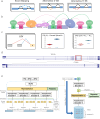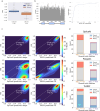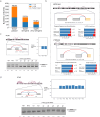This is a preprint.
Generative modeling for RNA splicing predictions and design
- PMID: 39896553
- PMCID: PMC11785043
- DOI: 10.1101/2025.01.20.633986
Generative modeling for RNA splicing predictions and design
Abstract
Alternative splicing (AS) of pre-mRNA plays a crucial role in tissue-specific gene regulation, with disease implications due to splicing defects. Predicting and manipulating AS can therefore uncover new regulatory mechanisms and aid in therapeutics design. We introduce TrASPr+BOS, a generative AI model with Bayesian Optimization for predicting and designing RNA for tissue-specific splicing outcomes. TrASPr is a multi-transformer model that can handle different types of AS events and generalize to unseen cellular conditions. It then serves as an oracle, generating labeled data to train a Bayesian Optimization for Splicing (BOS) algorithm to design RNA for condition-specific splicing outcomes. We show TrASPr+BOS outperforms existing methods, enhancing tissue-specific AUPRC by up to 2.4 fold and capturing tissue-specific regulatory elements. We validate hundreds of predicted novel tissue-specific splicing variations and confirm new regulatory elements using dCas13. We envision TrASPr+BOS as a light yet accurate method researchers can probe or adopt for specific tasks.
Conflict of interest statement
Competing Interests: The authors declare that they have no competing financial interests.
Figures















Similar articles
-
A CRISPR-dCas13 RNA-editing tool to study alternative splicing.Nucleic Acids Res. 2024 Oct 28;52(19):11926-11939. doi: 10.1093/nar/gkae682. Nucleic Acids Res. 2024. PMID: 39162234 Free PMC article.
-
mRNA-Seq of testis and liver tissues reveals a testis-specific gene and alternative splicing associated with hybrid male sterility in dzo.J Anim Sci. 2024 Jan 3;102:skae091. doi: 10.1093/jas/skae091. J Anim Sci. 2024. PMID: 38551023 Free PMC article.
-
Bayesian prediction of tissue-regulated splicing using RNA sequence and cellular context.Bioinformatics. 2011 Sep 15;27(18):2554-62. doi: 10.1093/bioinformatics/btr444. Epub 2011 Jul 29. Bioinformatics. 2011. PMID: 21803804
-
From computational models of the splicing code to regulatory mechanisms and therapeutic implications.Nat Rev Genet. 2025 Mar;26(3):171-190. doi: 10.1038/s41576-024-00774-2. Epub 2024 Oct 2. Nat Rev Genet. 2025. PMID: 39358547 Review.
-
Unannotated splicing regulatory elements in deep intron space.Wiley Interdiscip Rev RNA. 2021 Sep;12(5):e1656. doi: 10.1002/wrna.1656. Epub 2021 Apr 22. Wiley Interdiscip Rev RNA. 2021. PMID: 33887804 Review.
References
-
- Barash Y, Calarco JA, Gao W, Pan Q, Wang X, Shai O, Blencowe BJ, Frey BJ. Deciphering the splicing code. Nature. 2010; 465(7294):53–59. - PubMed
-
- Bend R, Cohen L, Carter MT, Lyons MJ, Niyazov D, Mikati MA, Rojas SK, Person RE, Si Y, Wentzensen IM, et al. Phenotype and mutation expansion of the PTPN23 associated disorder characterized by neurodevelopmental delay and structural brain abnormalities. European Journal of Human Genetics. 2020; 28(1):76–87. - PMC - PubMed
Publication types
Grants and funding
LinkOut - more resources
Full Text Sources
Research Materials
